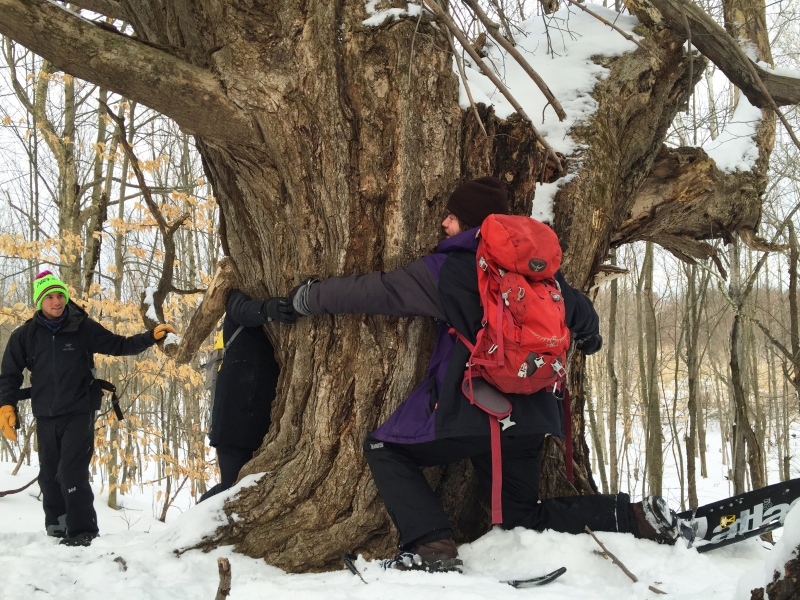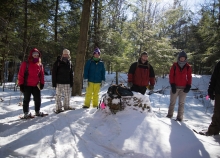
The Winter Buds
By Katherine Gilbert
It’s 3:00pm on an overcast Thursday, and nine kids are crammed into a timber-framed playhouse, decked out in ski pants and parkas, up to their ears in a pile of branches, twigs, and buds collected from the trees around Glen Meal State Forest. Heat pulses from a small space heater and rises up to the high-pitched ceiling while the students debate whether or not it is actually colder inside than outside in the snow. We’re all pretty tired out – navigating steep ridges, frozen ponds, and patches of frozen tangled undergrowth in snowshoes can be draining – and daunted by the collection of identical looking tree samples that we’re theoretically going to identify over the next hour.
ski pants and parkas, up to their ears in a pile of branches, twigs, and buds collected from the trees around Glen Meal State Forest. Heat pulses from a small space heater and rises up to the high-pitched ceiling while the students debate whether or not it is actually colder inside than outside in the snow. We’re all pretty tired out – navigating steep ridges, frozen ponds, and patches of frozen tangled undergrowth in snowshoes can be draining – and daunted by the collection of identical looking tree samples that we’re theoretically going to identify over the next hour.
Fortunately for us however, our fearless leader, Dr. Karl McKnight, had anticipated our needs, and appeared in the playhouse with a plateful of freshly baked chocolate cookies, and the atmosphere changes suddenly from one of exhaustion to merriment. Hand-lenses and dichotomous keys in hand, we eat the final cookie crumbs and get to work identifying eleven different species of deciduous trees.
It’s easy to assume in winter that the snow and sub-zero temperatures keep the animals at bay, and that branches free of leaves have nothing to offer the observer. But as we discovered this week, there actually is a whole lot going on despite the freeze. Already, buds have appeared on the trees, tiny dry seeds of the spring’s leafy green canopy. These are unique for every tree; for example, an American Beech has long, yellowish-tan buds with sharp tips and lots of scales, while the ends of a white birch’s twigs are festooned with clumps of smaller, dry grey buds. Red oaks can have tiny hairs of the margins (edges) of their bud scales, and yellow birches are characterized by the long lines of leaf scars below their shiny tan buds, representing the years that twig has grown new leaves.

~
During our snowshoeing, we encountered perhaps the oldest resident of Glen Meal: an immense old sugar maple with a trunk so wide it takes three six-foot-plus people’s arms to encircle it. According to Karl, this single tree is probably older than the United States, meaning that it must have endured around 250 North Country winters. Other sugar maples are not so lucky, as we can see from the nearby groves of stunted sugar seedlings with buds all munched by deer.
Down the hill from the old maple, we emerged from the forest and found ourselves at the edge of a frozen pond, covered in a thick layer of snow. From the edge, it looked like nothing more than a blank white expanse – one that we immediately began cutting up with our snowshoes – and a closer inspection revealed that a few brave shrews had braved the open to leave lines of their tiny trotting tracks across it. On the opposite shore, we came across the remains of a good old coyote party from the previous night. Paw prints showed where the coyotes had pranced and pounced, galloped and gallivanted through the snow, celebrating their life in the cold.

